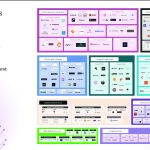
How Phaneesh Murthy Builds Systems That Transform $2 Million Companies Into Billion-Dollar Enterprises
Systematic approaches to organizational growth separate companies that achieve sustainable scale from those that plateau. Phaneesh Murthy’s three-decade career demonstrates how methodical frameworks, when properly implemented, can drive exponential expansion across diverse market conditions and technological shifts.
The Mechanics of Systematic Expansion
While serving first as Worldwide Head of Sales & Marketing, Phaneesh Murthy moved into the Product Solutions Group and served as a board member at Infosys, with his leadership resulting in growth from under $2 million to $750 million over a ten-year period. This transformation relied on structured processes rather than opportunistic growth.
The Global Delivery Model that Murthy helped develop at Infosys represented a systematic approach to service delivery. Teams operating across time zones created continuous work cycles, enabling 24-hour productivity without requiring individual employees to work extended hours. This framework became an industry standard because it addressed fundamental operational challenges through process design rather than individual heroics.
“Build it and they’ll come,” Murthy explained when describing the investment philosophy that characterized early expansion efforts. “We were just three employees when we bought 10 acres of land here.” The company started construction of 100,000 square feet, which could accommodate 1,000 employees when still in startup mode.
This proactive capacity building extended beyond physical infrastructure. Murthy’s teams developed intellectual property, service methodologies, and operational capabilities before customer demand materialized. This approach required significant capital commitment but created the structural capacity for rapid scaling when market opportunities emerged.
Engineering Sustainable Client Relationships
Traditional IT services companies pursued individual projects. Murthy introduced a fundamentally different engagement model focused on multi-year partnerships. “I’m not trying to sell a project. I’m trying to sell a relationship,” he explained, describing the philosophical shift that enabled long-term value creation.
The hiring approach for building these relationships prioritized attributes over experience. “It didn’t matter to me whether somebody was doing work in tea or selling soaps and shampoos or banking services or computers… as long as he was a tiger or she was a tiger, that’s all I care about.” This focus on learning agility and drive enabled rapid team expansion without limiting recruitment to the small pool of experienced IT professionals.
Training programs reinforced this relationship-centric approach. “We used to invest a lot in training,” Murthy noted. When questioned about the risk of trained employees leaving, his response was direct: “What happens if we don’t train them and they actually decide to stay? That’s even worse.”
Operational Frameworks for Scale
During his tenure as CEO of iGATE from 2003 to 2013, Murthy refined scaling methodologies through the Integrated Technology and Operations (iTOPS) model. During his time at iGATE, he disrupted the market again by introducing the iTOPS model, which he leveraged to successfully drive the enterprise value of iGATE up to US$4.8 billion from US$70 million over a period of 11 years.
The iTOPS framework systematized how technology solutions integrated with business process management. Rather than treating these as separate service lines, the model created unified delivery mechanisms that improved both efficiency and client outcomes. This operational standardization enabled iGATE to handle complex growth challenges, including the $1.22 billion acquisition of Patni Computer Systems—a company twice iGATE’s size at the time of purchase.
Standardization extended across multiple operational dimensions. Project management frameworks ensured predictable delivery regardless of team composition or geographic location. Quality assurance processes maintained consistent standards even as the organization expanded rapidly. Financial controls enabled accurate forecasting and resource allocation across a growing portfolio of client engagements.
Contemporary Applications
Murthy’s current work demonstrates how these scaling principles adapt to evolving market conditions. As of April 10, 2024, Murthy was appointed Senior Executive Advisory Board Member at CriticalRiver Inc., a global leader in digital transformation services. InfoBeans has brought on IT industry veteran Mr. Phaneesh Murthy as Advisor to the Board to help achieve their long-term growth goals in June 2024.
Through Primentor, the consulting firm he founded in 2013, Murthy applies these frameworks to contemporary challenges. Primentor Inc. to help mentor senior executives of large organizations “to create shareholder value by enhancing business agility in an uncertain environment”. The firm specializes in helping companies transition from traditional operational models to integrated approaches that leverage emerging technologies.
In Murthy’s advisory role with a prominent UK-based bank, he assisted the team in automating processes, increasing offshore responsibility to Indian associates, and boosting employee productivity to minimize overall expenses. This work demonstrates how scaling principles developed in IT services apply to established financial institutions navigating digital transformation.
At CriticalRiver, he focuses on fostering innovation and empowering employees to think creatively, while at InfoBeans, he guides the company’s transformation into an AI-first organization. These engagements show how systematic approaches to scaling must incorporate technological evolution while maintaining operational discipline.
Measurement and Continuous Refinement
Effective scaling requires comprehensive measurement systems that track both financial and operational metrics. While he served on the board, the EBITDA increased by 20 times its original value, playing a key role in the sale of the company to a well-known PE for $270 million in 2013, demonstrating the value creation potential of systematic improvement at CSS Corporation, where Murthy served as a board member.
Modern scaling systems incorporate metrics beyond traditional financial indicators. Client engagement depth, measured through the number of services provided and the strategic importance of engagements, provides early indicators of relationship health. Employee capability development rates track whether the organization maintains the human capital necessary for continued growth. Innovation metrics ensure that companies remain competitive as technology landscapes evolve.
“The idea is can I integrate a whole bunch of services, AI in it, analytics in it, maybe infrastructure cloud in it, maybe software in it, and business process in it and stuff like that, and offer it to the client,” Murthy explained when discussing future service models. This integrated approach requires measurement systems that can track value creation across multiple service dimensions rather than isolated metrics for individual offerings.
The Architecture’s Enduring Value
The systematic approach to scaling that Phaneesh Murthy developed addresses fundamental challenges that persist regardless of specific technologies or market conditions. By building capacity ahead of demand, creating relationship architectures that generate organic growth, standardizing operations for predictable delivery, and implementing comprehensive measurement systems, organizations position themselves for sustainable expansion.
Structuring outsourcing contracts so that both sides have incentives to make the other side successful and Pricing by output rather than effort in order to increase productivity and efficiency represent key principles Murthy discussed with Metis Strategy, highlighting how alignment of incentives drives sustainable growth.
These frameworks continue to influence how technology companies approach expansion. Organizations adopting systematic approaches to growth—investing ahead of demand, building relationship platforms, standardizing for scale, and measuring comprehensively—create the structural foundations necessary for transforming modest operations into global enterprises. The enduring relevance of these principles, demonstrated through their successful application across multiple decades and diverse market conditions, underscores their fundamental soundness as a blueprint for organizational scaling.












